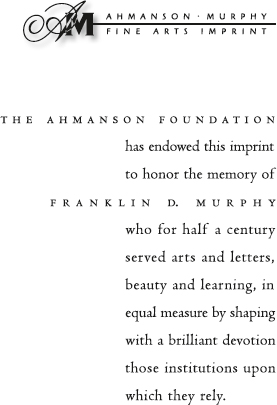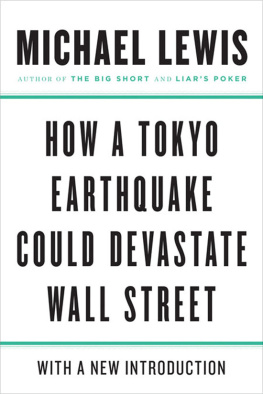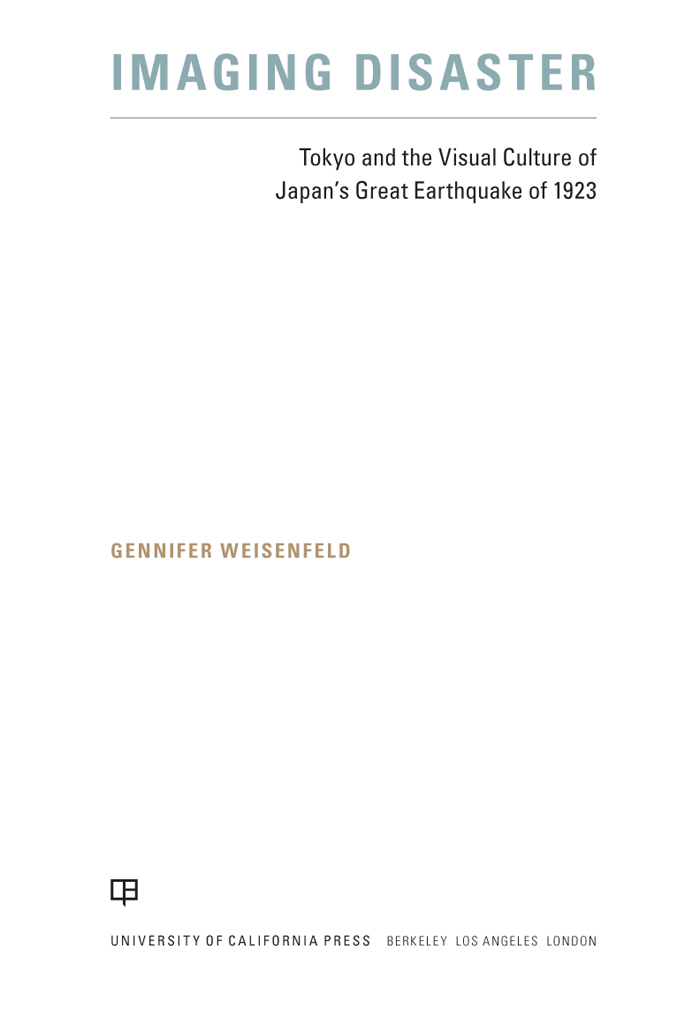
The publisher gratefully acknowledges the generous support and contributions of the following benefactors:
The Art Endowment Fund of the University of California Press Foundation, which was established by a major gift from the Ahmanson Foundation
Duke University
The Graham Foundation for Advanced Studies in the Fine Arts
IMAGING DISASTER

IMAGING DISASTER
Tokyo and the Visual Culture of
Japans Great Earthquake of 1923
GENNIFER WEISENFELD

University of California Press, one of the most distinguished university presses in the United States, enriches lives around the world by advancing scholarship in the humanities, social sciences, and natural sciences. Its activities are supported by the UC Press Foundation and by philanthropic contributions from individuals and institutions. For more information, visit www.ucpress.edu.
University of California Press
Berkeley and Los Angeles, California
University of California Press, Ltd.
London, England
2012 by The Regents of the University of California
Every effort has been made to identify the rightful copyright holders of material not specifically commissioned for use in this publication and to secure permission, where applicable, for reuse of all such material. Credit, if and as available, has been provided for all borrowed material either on-page, on the copyright page, or in an acknowledgment section of the book. Errors or omissions in credit citations or failure to obtain permission if required by copyright law have been either unavoidable or unintentional. The author and publisher welcome any information that would allow them to correct future reprints.
Title page and chapter opening details are as follows: title page, Marunouchi (). Full credit information appears in the captions for the listed images.
Library of Congress Cataloging-in-Publication Data
Weisenfeld, Gennifer S. (Gennifer Stacy), 1966
Imaging disaster : Tokyo and the visual culture of Japans Great Earthquake of 1923 / Gennifer Weisenfeld. 1st [edition].
pages cm. (Asia: local studies/global themes ; 22)
Includes bibliographical references and index.
ISBN 978-0-520-27195-1 (cloth : alk. paper)
1. Arts, Japanese20th centuryThemes, motives. 2. Kanto Earthquake, Japan, 1923. 3. Earthquakes in art. 4. Arts and societyJapanHistory20th century. 5. EarthquakesSocial aspectsJapan. I. Title.
NX584.A1W45 2012
704.9'49952032dc23 | 2012003245 |
Manufactured in China
21 20 19 18 17 16 15 14 13 12
10 9 8 7 6 5 4 3 2 1
The paper used in this publication meets the minimum requirements of ANSI/NISO Z39.481992 (R 2002) (Permanence of Paper).
For Derek and Luci
CONTENTS
PREFACE
Anyone who has lived or worked in areas along the Pacific Rim ring of fire knows that earthquakes and related natural disasters are always a possibility. But having just completed years of research on the devastating 7.9-magnitude earthquake that flattened Tokyo and surrounding areas in 1923, perhaps I am more fixated on this topic than most. I vividly remember a friendly yet chilling chat with an elderly neighbor in the downtown Kachidoki district of Ch ward in Tokyo, where I lived in a charming, if slightly rundown, old wooden nagaya (row house) on one of the small back streets of this working-class neighborhood. I had been told that my neighbor lived through the 1923 quake as a young child, and while hesitant to ask about his experiences, I eagerly sought his advice about evacuation plans and sites if another temblor hit. His answer was sobering: Dont even bother. This place will burn to the ground. No matter how much we plan, nature offers no guarantees.
The 1923 quake is unparalleled in Japans modern history in its combined seismic scale and extent of damage; in fact, it was one of the worlds worst natural disasters of the early twentieth century. In terms of loss of life and material damage, it is still Japans worst national disaster. But when the unprecedented 9.0-magnitude earthquake of 11 March 2011 hit off the coast of Thoku, the northeastern region of Japan, followed by hundreds of strong aftershocks, people throughout the world were reminded of modern humanitys fragility in the face of nature. Not only did the quake produce another massive tsunami that washed away the coastline, but also like its 1923 predecessor, it generated a torrent of images that saturated the visual field. Given that I was already The compelling visual lexicon of disaster is enduring and undeniable.
How do these thousands of images of ruined landscapes and graphic representations of death and destruction act on us to evoke emotions or to provoke action? The producers of the images, consciously or unconsciously, stake a claim to a particular meaning for disasters, and they communicate this meaning to us through both form and content. My study of the visual responses in 1923 suggests that disasters provide opportunities for individuals, societies, and nations to articulate their diverse agendas for urban, social, political, or moral reform. After a disaster, everyone is a critic, even when the criticism is couched in the collectivist rhetoric of national resilience. The striking similarity between criticisms in 1923 and 2011with accusations of political ineptitude and malfeasance and comments about the moral turpitude of modern society or the pitfalls of technological hubrisreveal powerful parallels between the past and the present.
Despite claims of a shared national trauma when disaster strikes, inequitable social structures and economic development policies expose certain members of the populace to greater risk and suffering than others. Recent newspaper editorials, such as Oguma Eijis trenchant commentary in the Asahi shinbun on the Thoku regions particular structural vulnerabilities, have underscored this point. Oguma, a historical sociologist at Keio University in Tokyo who has written about the postwar origins of Japans myth of a homogeneous nation, points out that the poorer rural regions of the northeast initially provided cheap labor and food for the countrys burgeoning metropolises to the west and then, when faced with international competition and depopulation, had little choice but to allow hazardous nuclear energy development, which left them particularly vulnerable to the 2011 disaster. Like the unfortunate victims of the 1923 temblor, who were disproportionately from the poorer neighborhoods of Tokyos low city (shitamachi), Thoku residents are suffering more now because of historical class and regional inequities.
In 1923, the fundamental power of the Japanese nation-state defined the quake experience as a national triumph against adversity that produced the gleaming new Tokyo metropolis. The more recent disaster is still unfolding as this book goes to press, so we do not yet know what the master narrative of the event will be, particularly with the added horrific element of nuclear radiation contamination, and whether the Japanese state is strong enough to direct it. But it is already clear that in the national and international mass media, the nuclear disaster story has superseded the natural one, reinforcing scholars common assertion about disasters: whatever their triggering eventnatural or humanthey all have aspects that are man-made.








